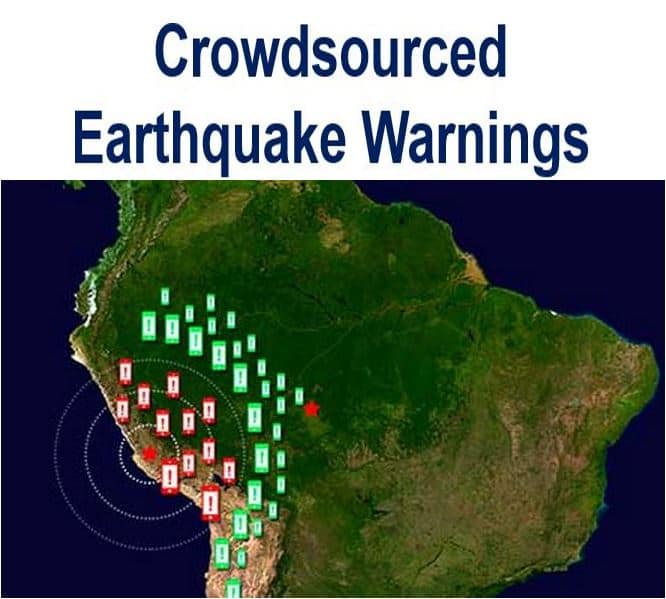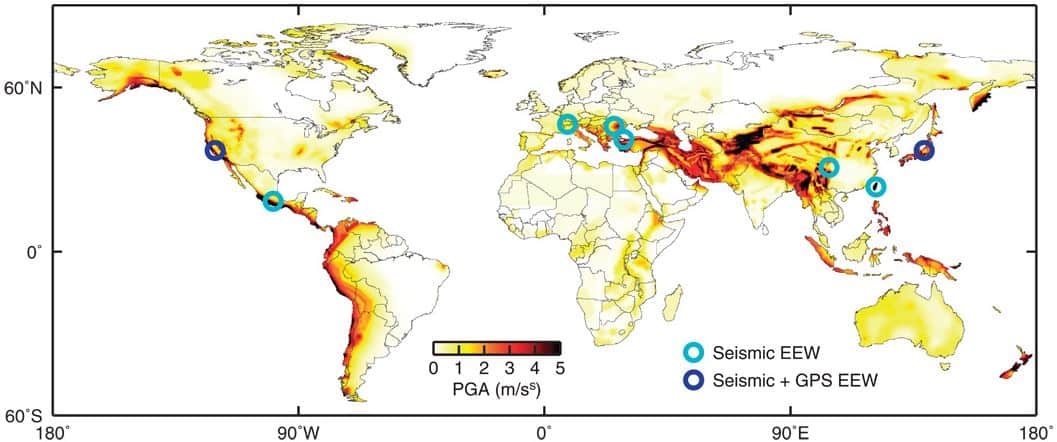Smartphones could be used as early-warning systems for major earthquakes, as well as other personal electronic devices, scientists at the U.S. Geological Survey said. Smartphones would be useful in parts of the world that cannot afford costly earthquake warning systems.
The research team, who published details of their study in the new AAAS journal Science Advances (citation below), found that sensors in portable communication devices and some others could be utilized to build earthquake warning systems.
Even though they are not as accurate as state-of-the art, science-grade equipment, the Global Positioning System (GPS) receiver in a smartphone is able to detect the permanent ground movement (displacement) caused by fault motion in a major earthquake.

Mobile phones can detect ground motion and warn others before strong shaking arrives. Base map originally created by NASA. (Credit: Emiliano Rodriguez Nuesch with Pacifico)
By utilizing crowd-sourced observations from participants using their smartphones, it would be possible to detect and analyze earthquakes, and transmit customized warnings back to users.
Crowdsourcing can help communities
Lead author, Sarah Minson, a US Geological Survey (USGS) geophysicist, who was working on post-doctoral research at Caltech during the study, said:
“Crowd-sourced alerting means that the community will benefit by data generated from the community.”
Early warning systems detect when an earthquake starts and rapidly send warnings to people and automated systems before they sense the land movement at their locations.
There are several regions in the world where populations are vulnerable to earthquake damage. Earthquake early warning (EEW) systems today only operate in a few regions, including Mexico and Japan.
Project leader, Benjamin Brooks, a USGS geophysicist, said:
“Most of the world does not receive earthquake warnings mainly due to the cost of building the necessary scientific monitoring networks.”
Brooks and colleagues tested the feasibility of crowd-sourced EEW with a simulation of a major earthquake (magnitude 7), and with real data from Japan’s 2011 magnitude 9 Tohoku-oki quake.
Not that many contributors required
According to their results, crowd-sourced EEW was possible with just a tiny proportion of people in a given area contributing data from their smartphones.
For example, if mobile phones from fewer than 5,000 owners in a large metropolitan area responded, the earthquake could be detected and analyzed with enough time to transmit a warning to areas farther away before the onset of strong shaking.
Co-author, Professor Craig Glennie, who works at the University of Houston, said:
“The speed of an electronic warning travels faster than the earthquake shaking does.”

Symbols show the few regions globally where public citizens and organizations currently receive earthquake warnings and the types of data used to generate those warnings. Background color is peak ground acceleration with 10% probability of exceedance in 50 years from the Global Seismic Hazard Assessment Program. (Image: Science Advances)
The researchers found that the sensors in their mobile phones and similar devices could be used to transmit quake warnings for tremors of magnitude 7 or larger, but not for smaller, yet potentially damaging earthquakes.
Comprehensive EEW is only possible with a dense network of scientific instruments. Scientific-grade EEW, such as the SharkeAlert system of the USGS that is currently being implemented in the US West Coast, will be able to help reduce the impact of earthquakes over a wide range of magnitudes.
However, in several parts of the world where resources are not available for such sophisticated systems, but consumer electronics are increasingly common, crowd-sourced EEW has considerable potential.
USGS coordinator of the ShakeAlert Earthquake Early Warning System, Douglas Given, said:
“The U.S. earthquake early warning system is being built on our high-quality scientific earthquake networks, but crowd-sourced approaches can augment our system and have real potential to make warnings possible in places that don’t have high-quality networks.”
Pilot project in Chile
The US Agency for International Development has agreed to finance a pilot project together with the Chilean Centro Sismológico Nacional to try out a pilot hybrid earthquake warning system consisting of stand-alone smartphone sensors and scientific-grade sensors along Chile’s coast.
Bob Iannucci, of Carnegie Mellon University, Silicon Valley, said:
“The use of mobile phone fleets as a distributed sensor network — and the statistical insight that many imprecise instruments can contribute to the creation of more precise measurements – has broad applicability including great potential to benefit communities where there isn’t an existing network of scientific instruments.”
Co-author, Professor of Engineering Seismology at Caltech, Thomas Heaton, said:
“Thirty years ago it took months to assemble a crude picture of the deformations from an earthquake. This new technology promises to provide a near-instantaneous picture with much greater resolution.”
Co-author Susan Owen of NASA’s Jet Propulsion Laboratory, Pasadena, California, said:
“Crowd-sourced data are less precise, but for larger earthquakes that cause large shifts in the ground surface, they contain enough information to detect that an earthquake has occurred, information necessary for early warning.”
Citation: “Crowdsourced earthquake early warning,” Sarah E. Minson, Benjamin A. Brooks, Craig L. Glennie, Jessica R. Murray, John O. Langbein, Susan E. Owen, Thomas H. Heaton, Robert A. Iannucci, and Darren L. Hauser. Science Advances. Published 10 April, 2015. DOI: 10.1126/sciadv.1500036.
